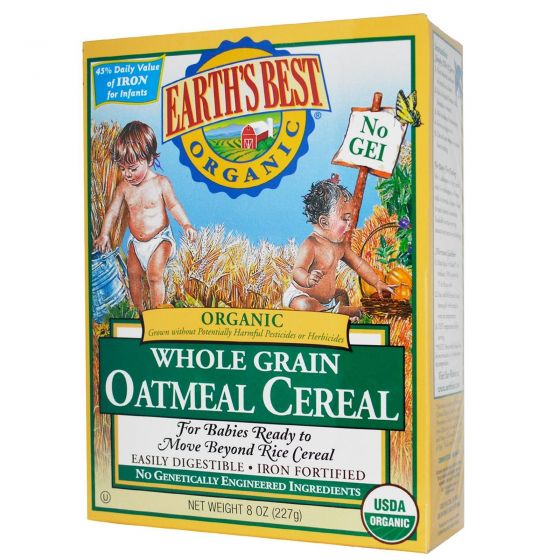
 4
4



Judith Browning wrote:I've never used this flour...we grind organic wheat berries but what is striking to me is the "safe handling" instructions at the bottom of the label Lisa posted.
That alone would keep me from using this flour.
How could you be comfortable kneading bread bare handed and especially the standard cookie dough treat with the grandkids?
 3
3



 6
6



 3
3



Lisa Brunette wrote:
It's also a manufactured free glutamate: https://www.truthinlabeling.org/names.html
 3
3



 5
5



 4
4



“The most important decision we make is whether we believe we live in a friendly or hostile universe.”― Albert Einstein
 2
2




Ingredients
Organic Whole Grain Oat Flour, Vitamins & Minerals (Calcium Phosphate, Ferric Pyrophosphate, Folic Acid, Alpha Tocopheryl Acetate (Vitamin E), Niacinamide (Vitamin B3), Zinc Oxide, Cyanocobalamin (Vitamin B12), Thiamine Mononitrate (Vitamin B1), Riboflavin (Vitamin B2), Pyridoxine Hydrochloride (Vitamin B6)), Alpha Amylase (Enzyme). OATS MAY CONTAIN WHEAT.
 3
3



Almond Thompson wrote:I think this has been added to things for sometime. .....
Is this the same thing?
“The most important decision we make is whether we believe we live in a friendly or hostile universe.”― Albert Einstein
 6
6



 4
4



Invasive plants are Earth's way of insisting we notice her medicines. Stephen Herrod Buhner
Everyone learns what works by learning what doesn't work. Stephen Herrod Buhner



Saralee Couchoud wrote:I guess I would recommend buying whole wheat berries and grinding it yourself. I plan to take it a step further and grow the wheat myself. I have seed for seven different varieties and one variety of rye. They don't cross pollinate so I can grow all of them side by side. I got my seed from "seed up " out of Phoenix. It is all organic and ancient grains starting with enkorn wheat which is biblical ere to the latest one that is from the 1800s
 1
1



Donn Cave wrote:
Lisa Brunette wrote:
It's also a manufactured free glutamate: https://www.truthinlabeling.org/names.html
Is it? From the reference, I have the impression it probably isn't at all, as it comes in the bag. When the glutamates might appear, is after you've baked the bread.
Malted barley, though, they say could have some glutamate. For your purposes, between the two, fungal alpha-amylase might be a better bet than malted barley.
My thinking on the chemistry:
glutamate is a form of glutamic acid, an amino acid that's a constituent of all proteins. When the protein is broken down to amino acids, and the glutamic acid is freed, it joins with some cation like sodium and becomes (e.g.) monosodium glutamate. Enzymes are proteins that can participate in chemical reactions, like breaking starch molecules into sugars (amylase.) Malted barley has those amylase enzymes - or had them. It's a source of maltose, a simple disaccharide that the enzymes produce from starch. It's possible to provide the malted barley with its enzymes intact - "diastatic malt" - but the effect on bread is not very desirable. (Maybe some people like it, but I'd call it awful.) Much more commonly, the malt is toasted, which denatures the enzyme - and as truthinlabeling surmises, could possible break off some glutamates. Whatever the purpose of the fungal alpha-amylase, it's apparently an active enzyme, which means its protein is intact and there's no obvious reason why it would come with glutamates. The question would be how baking the bread would affect the enzyme. I can only guess, but likely the enzyme is denatured - its special conformation is ruined so it can no longer break down starch - but that's easy because it typically involves weak hydrogen bonds. I wouldn't guess that it converts the protein to its amino acid constituents, but there'd be some clue to this in the manufacturing processes that do produce glutamates from protein - are they similar to the internal temperature of baked bread?
 3
3



 2
2



 5
5



 3
3



To be is to do …Kant
To do is to be ..Nietzsche
Do be do be do…Sinatra
Scooby dooby do …St. Thomas
 4
4



 6
6



https://againfarmstead.com/ | @againandagainfarmstead
 3
3



 3
3



Invasive plants are Earth's way of insisting we notice her medicines. Stephen Herrod Buhner
Everyone learns what works by learning what doesn't work. Stephen Herrod Buhner
 2
2



Anne Miller wrote:Welcome to the forum.
Just curious, what is Alpha Gal syndrome?
“If we are honest, we can still love what we are, we can find all the good there is to find, and we may find ways to enhance that good, and to find a new kind of living world which is appropriate for our time.” ― Christopher Alexander
 7
7



“If we are honest, we can still love what we are, we can find all the good there is to find, and we may find ways to enhance that good, and to find a new kind of living world which is appropriate for our time.” ― Christopher Alexander
 2
2









